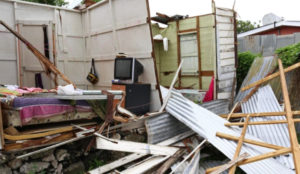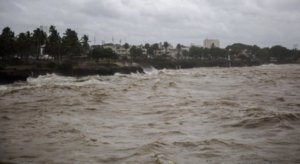
Tropical Storm Elsa has battered the southern coasts of Haiti and the Dominican Republic, downing trees and blowing off roofs as it moved through the Caribbean, killing at least three people.
A 15-year-old boy and a 75-year-old woman died in separate events in the Dominican Republic last Saturday after walls collapsed on them, while a third death was also reported in St Lucia.
Elsa was clocking maximum sustained winds at 70 miles per hour (110kmph), but slowed down as it passed between Haiti and Jamaica. Elsa has now been downgraded to a tropical storm from a hurricane.
In the Dominican Republic, some flooding was reported in San Cristobal province, prompting about 100 evacuations, while waves of 12-14 feet (356-427cm) washed debris ashore in the capital, Santo Domingo.
Haiti, which saw 31 deaths in Hurricane Laura in August, had not ordered evacuations, but authorities used social media to alert people about the storm and urged them to evacuate if they lived near water or mountain flanks.
“The whole country is threatened,” the Civil Protection Agency said in a statement. “Make every effort to escape before it’s too late.”

Director Jerry Chandler told media that the Civil Protection Agency is running low on basic items including food and water as a recent surge in gang violence has already displaced thousands of local people from their homes.
“It’s been three weeks that we’ve been supporting families who are running away from gang violence,” he said. “We are working at renewing our stocks, but the biggest problem is logistics.”
In Barbados, more than 1,100 people reported damaged houses, including 62 homes that completely collapsed. The government promised to find and fund temporary housing to avoid clustering people in shelters amid the pandemic.
Meanwhile, officials on Saturday reported at least 43 homes and three police stations damaged in St Vincent and the Grenadines, which also suffered massive volcanic eruptions that began in April.
Elsa made landfall along Cuba’s southern coast last Monday afternoon as forecasters said it could then turn toward Florida. Elsa’s center was some 85 miles southeast of Havana, scampering northwest at 14 mph.
On Sunday, Cuban officials had evacuated 180,000 people as a precaution against the possibility of heavy flooding. Most of those evacuated stayed at relatives’ homes, others went to government shelters, and hundreds living in mountainous areas took refuge in caves prepared for emergencies.
The hurricane center said the storm was likely to gradually weaken while passing over central Cuba but “slight re-strengthening is forecast after Elsa moves over the southeastern Gulf of Mexico.”
Elsa was the first hurricane of the Atlantic season and the earliest fifth-named storm on record. It also broke the record as the tropic’s fastest-moving hurricane, clocking in at 31mph (50kmph) on Saturday morning, according to Brian McNoldy, a hurricane researcher at the University of Miami.


